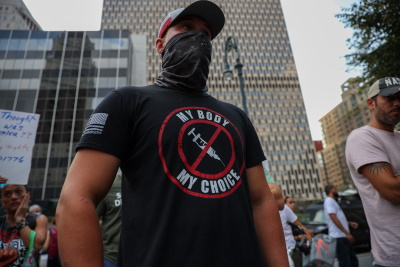Q: How do people who have not been vaccinated against COVID-19 pose a risk to people who have been vaccinated?
A: An unvaccinated person who is infected with COVID-19 poses a much greater risk to others who are also unvaccinated. But vaccines are not 100% effective, so there is a chance that an unvaccinated person could infect a vaccinated person — particularly the vulnerable, such as elderly and immunocompromised individuals.
FULL QUESTION
How can the unvaccinated possibly pose a threat to the vaccinated? How does that work? What is the risk exactly?
FULL ANSWER
The question above was not asked by a SciCheck reader; it was posed by Tucker Carlson on his Fox News show on Sept. 13.
At the time, Carlson was discussing the Sept. 9 speech in which President Joe Biden announced that he had directed the Labor Department to develop a temporary emergency rule for businesses with 100 or more employees that would require workers to be fully vaccinated or be tested for the SARS-CoV-2 coronavirus at least once a week.
 “The bottom line: We’re going to protect vaccinated workers from unvaccinated co-workers,” Biden said. “We’re going to reduce the spread of COVID-19 by increasing the share of the workforce that is vaccinated in businesses all across America.”
“The bottom line: We’re going to protect vaccinated workers from unvaccinated co-workers,” Biden said. “We’re going to reduce the spread of COVID-19 by increasing the share of the workforce that is vaccinated in businesses all across America.”
Carlson argued that Biden’s proposal was about controlling Americans — not about public health — and questioned why the vaccinated needed to be protected.
“Virtually every sentence of the speech reinforced a single point again and again. And it was this: Your fellow Americans are dangerous to you,” Carlson said in the segment, clips of which have received around 1 million views on Facebook and Instagram. “They could kill you. And that includes your family, it includes your friends, it includes the people you sit next to at work. All of these people are threats to you and only the Biden administration can save you.”
“Think about that for a moment,” Carlson continued. “Does it make sense? If the vaccine works — and they assure us adamantly that it does work and they punish us if we question how well it works — then how can the unvaccinated possibly pose a threat to the vaccinated? How? What exactly is the risk exactly to the vaccinated from the unvaccinated? Joe Biden didn’t tell us the answer. He didn’t tell us because he doesn’t know. No one knows. There is no answer.”
It’s not the first time that Carlson has cast doubt on the effectiveness of the vaccines. But experts told FactCheck.org that unvaccinated people with COVID-19 are a potential threat to people who have been fully immunized against the disease.
“When people ask me, ‘What’s the worst thing that anti-vaccine people say,’ it’s when they say, ‘What do you care what I do? You’re vaccinated,’” Dr. Paul Offit, director of the Vaccine Education Center at the Children’s Hospital of Philadelphia, told us in a phone interview.
Offit said that thinking is based, in part, on the incorrect assumption that the vaccines are 100% effective at preventing an infection or illness, which is not true of any vaccine.
The Risk
Although all of the vaccines approved and authorized for use in the United States are effective at preventing symptomatic disease, so-called “breakthrough” cases of COVID-19 after vaccination are to be expected — perhaps even more so now because of the more contagious delta variant of the virus.
In a Sept. 17 update on COVID-19 epidemiology and vaccines, the Centers for Disease Control and Prevention included an analysis of several studies conducted in the U.S. and other countries on vaccine effectiveness against the delta variant. The update said that since the introduction of delta, vaccine effectiveness against hospitalization ranged from 75% to 95% and effectiveness against infection ranged from 39% to 84% — depending on the region. That compared with a pre-delta range of 84% to 97% effectiveness against hospitalization and a range of 72% to 97% effectiveness against infection.

“Even if you’ve gotten a vaccine there is still a chance,” albeit a “much lower” one, “that you can get symptomatic infection” after contracting the virus from an unvaccinated person, Offit explained. “There is still a chance that you can get serious infection and there is still a chance you can be hospitalized or die from that infection.”
In particular, immunocompromised people, who already have moderately to severely weakened immune systems, “are especially vulnerable to COVID-19, and may not build the same level of immunity” from the vaccines compared with people who are not immunocompromised, the CDC says. That’s why the Food and Drug Administration authorized a third dose of the mRNA vaccines for certain immunocompromised people.
Dr. Mounzer Agha, a hematologist and director of the Mario Lemieux Center for Blood Cancers at the University of Pittsburgh Medical Center who has studied blood cancers and the vaccines, told the Washington Post in May that in order for cancer patients who don’t develop immunity from the vaccines to be protected, they need people around them to be vaccinated. “Everyone knows someone who has cancer. And if you care about that person, you should get the vaccine and tell your friends to get it,” Agha told the Post.
Also, studies show vaccine effectiveness against infection and milder forms of illness wanes over time, and the elderly can experience immunosenescence, a decreased immune response due to aging. On Sept. 17, the FDA’s Vaccines and Related Biological Products Advisory Committee unanimously recommended an emergency use authorization for a booster dose of the Pfizer/BioNTech vaccine for those age 65 and older and those at “high risk of severe COVID-19,” to be given at least six months after completion of the primary two-dose series.
Update, Sept. 25: The FDA amended the Pfizer EUA to allow for the booster shots, and the CDC issued recommendations for certain populations. Those recommendations say that people age 65 and older, residents in long-term care facilities, and people age 50 to 64 with underlying medical conditions should get a booster shot of the Pfizer/BioNTech vaccine at least six months after they completed the primary two-shot series. The agency said that two other groups – those age 18 to 49 with underlying medical conditions or 18 to 64 with increased risk of exposure to COVID-19 because of their jobs or institutional setting – “may” get a booster shot in the same time frame “based on their individual benefits and risks.”
The CDC tracks reports of hospitalizations and deaths that occur after “breakthrough infection,” which is the term it uses when a person contracts the coronavirus that causes COVID-19 at least two weeks after receiving all recommended doses of one of the approved or authorized vaccines. The agency used to report all known instances of breakthrough cases, including the asymptomatic and mild infections, but changed its reporting system in May to focus on “severe cases of vaccine breakthrough.”
As of Sept. 13, the CDC had received reports of 15,790 patients with a COVID-19 vaccine breakthrough infection who were hospitalized or died. That was out of more than 178 million people in the United States who had been fully vaccinated against COVID-19.
About one-fifth of the deaths (516 of 3,040) and hospitalizations (2,562 of 12,750) were “asymptomatic or not COVID-related,” the CDC said.
The Children’s Hospital of Philadelphia actually answered Carlson’s question years ago, in a pre-COVID-19 featured article titled “If Vaccines Work, Why Do Unvaccinated People Pose a Risk?”
In addition to the point about all vaccines being less than 100% effective, the September 2017 CHOP post noted that more unvaccinated people in a population leads to more virus transmission.
“The greater the number of unvaccinated people in a community, the more opportunity germs have to spread. This means outbreaks are more difficult to stem and everyone is at greater risk of exposure — including vaccinated people,” it said.
Johns Hopkins University epidemiologist David Dowdy made a similar point.
“Unfortunately, while the vaccines are highly effective — and particularly effective against serious disease — they are not perfect,” he told us in an email. “Whenever transmission rates go up, therefore, the risk goes up for everyone.”
Based on the number of COVID-19 cases, Dowdy calculated that when compared with mid-June, the risk of developing COVID-19 in the U.S. — regardless of vaccination status — had increased 15-fold as of mid-September, when the CDC said there was high community transmission in every state.
“In other words, there is a higher risk of a vaccinated person getting COVID-19 in September than of an unvaccinated person getting COVID-19 back in June — just because everyone’s risk has gone up,” Dowdy said.
Still, the risk is higher for the unvaccinated. A CDC study published Sept. 10 — but based on data from April to mid-July — found that, due to the delta variant, the unvaccinated (including those who were only partially vaccinated) were nearly five times more likely to become infected, about 10 times more likely to require hospitalization and almost 11 times more likely to die from COVID-19 than fully vaccinated individuals.
And in several states, there are so many COVID-19-related hospitalizations — the vast majority of which are unvaccinated patients — that beds in intensive care units are near capacity, making it difficult not only to treat COVID-19 patients but those with medical emergencies not related to the disease.
It’s also possible that an unvaccinated individual could transmit the virus to a vaccinated parent who could pass it on to a child or children under the age of 12, who currently are not eligible to be vaccinated. On Sept. 20, Pfizer and BioNTech announced clinical trial results showing that its vaccine was safe and effective for children ages 5 to 11 — but the vaccine still needs to be authorized or approved for that age group by the FDA.
In a Sept. 15 Washington Post opinion piece, Dr. Leana Wen, an emergency physician and visiting public health professor at George Washington University, and Sam Wang, a professor of neuroscience at Princeton University, compared being unvaccinated in public to drunken driving.
“Some who argue that vaccination is solely a matter of individual choice would say that you can choose to protect yourself. If you’re vaccinated, why do you care if others around you aren’t?” the professors wrote. “But again, consider the analogy: Three out of every eight people killed are not the intoxicated driver, but their passengers or people in other vehicles. Similarly, with covid-19, the risk is borne not only by the person making the decision but also by others who cross their path.”
“The vaccine is simultaneously like a great seat belt and a choice to drive sober,” they added. “The seat belt reduces your chance of severe injury in an accident. Driving sober reduces the risk of the accident in the first place. The vaccine does both, but it still matters if you’re surrounded by reckless drivers. No vaccine is 100 percent effective, and the more virus is around us — in this case, carried by the unvaccinated, who are five times more likely to be infected and thus to spread coronavirus — the more likely the vaccinated are to become infected.”
Not everyone will agree with that comparison, but it is nevertheless an illustration of the risk that exists.
Editor’s note: SciCheck’s COVID-19/Vaccination Project is made possible by a grant from the Robert Wood Johnson Foundation. The foundation has no control over FactCheck.org’s editorial decisions, and the views expressed in our articles do not necessarily reflect the views of the foundation. The goal of the project is to increase exposure to accurate information about COVID-19 and vaccines, while decreasing the impact of misinformation.
Sources
White House. “Remarks by President Biden on Fighting the COVID-19 Pandemic.” Transcript. 9 Sep 2021.
“Tucker Carlson Tonight.” Transcript and video. Fox News. 13 Sep 2021.
Dr. Paul Offit, director of the Vaccine Education Center at the Children’s Hospital of Philadelphia. Interview with FactCheck.org. 15 Sep 2021.
Dr. David Dowdy, Johns Hopkins University associate professor of epidemiology. Email sent to FactCheck.org. 15 Sep 2021.
FactCheck.org. “How effective are the vaccines?” 4 Mar 2021, updated 26 Aug 2021.
McDonald, Jessica. “Vaccines Remain Largely Effective Against Delta Variant, Counter to Claims From Fox News Guest.” FactCheck.org. 30 Jul 2021, updated 23 Aug 2021.
Centers for Disease Control and Prevention. COVID-19 Vaccine Breakthrough Case Investigation and Reporting. Cdc.gov. Accessed 16 Sep 2021.
Children’s Hospital of Philadelphia. “Feature Article: If Vaccines Work, Why Do Unvaccinated People Pose a Risk?” Chop.edu. 12 Sep 2017.
Children’s Hospital of Philadelphia Vaccine Education Center. “Vaccinated or Unvaccinated: What You Should Know.” Q&A sheet. 2017.
Wen, Leana and Sam Wang. “Opinion: Remaining unvaccinated in public should be considered as bad as drunken driving.” Washington Post. 16 Sep 2021.
McDonald, Jessica. “Biden’s Controversial COVID-19 Vaccine Booster Plan.” FactCheck.org. 3 Sep 2021, updated 17 Sep 2021.
Spencer, Saranac. “Tucker Carlson Misrepresents Vaccine Safety Reporting Data.” FactCheck.org. 14 May 2021.
Oliver, Sara. “Updates to COVID-19 Epidemiology and COVID-19 Vaccines.” Vaccines and Related Biological Products Advisory Committee. Meeting Presentation. 17 Sep 2021.
Scobie, Heather, et al. “Monitoring Incidence of COVID-19 Cases, Hospitalizations, and Deaths, by Vaccination Status — 13 U.S. Jurisdictions, April 4–July 17, 2021.” Morbidity and Mortality Weekly Report. 10 Sep 2021.
Holcombe, Madeline. “These 5 states have less than 10% of ICU beds left as Covid-19 overwhelms hospitals.” CNN. 1 Sep 2021.
Coleman, Justine. “Three-quarters of ICU beds across country are full.” The Hill. 25 Aug 2021.
Department and Health and Human Services. Hospital Utilization. Accessed 17 Sep 2021.

